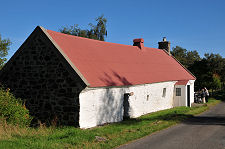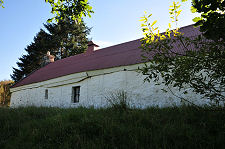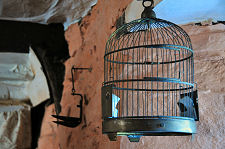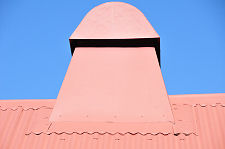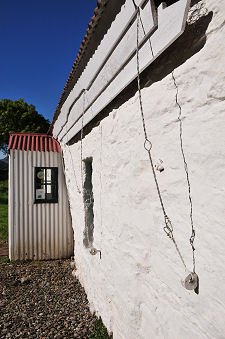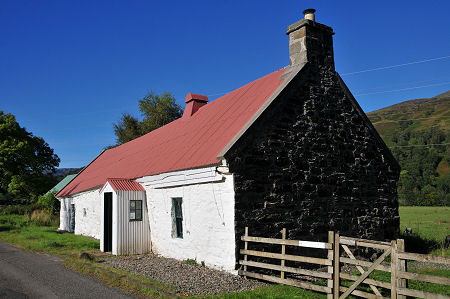 Moirlanich Longhouse |
Just beyond the northern edge of Killin a minor road takes a left turn off the A827 and heads north-west into remote Glen Lochay. If you take the turn you pass a large electricity substation, a consequence of the hydro-electric power schemes in the area. A few hundred yards further on, and a couple of centuries back in time, you come to the Moirlanich Longhouse, a remarkable survival of a Scottish longhouse, a way of living once common across the Highlands of Scotland. There's a car park for visitors on the left a short distance before you reach the longhouse itself, and from there you walk to the visitor reception and exhibition, in the green tin building just beyond the longhouse.
People have been living around the western end of Loch Tay since Neolithic times and it is known that a settlement has existed at Moirlanich for at least five centuries, and probably much longer. Today the settlement is gone and the name applies only to the longhouse.
The Robertson family were Gaelic-speaking tenant farmers who moved to the settlement in 1809, when the name first appears on tenant records. They seem to have taken up residence in the longhouse when it was built in, it is thought, some time after 1850, and they lived there until 1968, when the last member of the family died.
Moirlanich Longhouse was purchased by the National Trust for Scotland in 1992. By this time it was in a fairly sorry state. Two of the five main "crucks" or timber frames placed cross-wise to support the roof had slipped from their supports in the walls below, and as a result the weight of the roof was forcing the main walls, which are largely of dry stone construction with lime mortar pointing, apart. This rendered the whole structure liable to collapse
When it was originally built, the longhouse had a roof that comprised a layer of wood laid vertically over the framework below. This was covered by a layer of turf, and this in turn was covered by thatch. Roofs like this took a lot of labour to maintain, and in the 1940s the turf and thatch were discarded in favour of a roof make of corrugated iron. Killin is home to an unusually rich collection of corrugated iron buildings, ranging from a church to an outhouse, and perhaps the change seemed to the Robertsons to be a concession to the modern world.
Today's visitor enters by means of the corrugated iron porch that was, presumably, added at the same time as the thatched roof was replaced. This gives access to the kitchen, the heart of the longhouse. The kitchen itself is dominated by the large "hanging lum", the large cowl above the kitchen fire. This looks remarkably primitive to modern eyes, but was actually a major advance over the system - if that's not too strong a word - that preceded it in earlier blackhouses, of having a fire in a central hearth in the floor, and letting the smoke escape through the turf and thatch of the roof as best it could.
The remarkable thing about the hanging lum is that it was constructed from planks of timber sealed with newspaper and old rags (this was, remember, a structure intended to hang above a fire that was rarely if ever extinguished). Cooking was accomplished by hanging pots and kettles above the wood or peat fire, which also formed the main source of artificial light in the room. To the rear of the kitchen is a small bedroom, with a box bed.
To the right of the kitchen, as you view the building from the front, is the parlour. This served as a reception room for important visitors, and it also has at the rear two box beds. Each has curtains that can be drawn to provide additional warmth, and to screen the beds when the parlour was in use. Not that it was in use very often, however. No living local resident who the NTS were able to talk to had ever been in the parlour. It's not that the Robertsons were anti-social, it's simply that day-to-day entertaining was always done in the kitchen.
The room has been restored as it would have been in the 1930s. Of particular note are the multiple layers of wallpaper on the walls. Presumably as each new layer added insulation and (a little) structural integrity to the building, there was no incentive to remove old layers when redecorating. During restoration it was found that the oldest wallpaper layer incorporated a page from The Scotsman dated 1902. The fireplace is obviously intended to burn coal, and includes elements that seems to date back to the 1700s, presumably having first been fitted in another, rather grander, building.
On the other side of the kitchen a passage leads through to the byre. Scottish longhouses, like the earlier blackhouses, were intended to provide accommodation under one roof for a family and their livestock. This gave real advantages in terms of security and shelter for the animals, and warmth for the humans. In many longhouses the livestock and the human residents shared a single entrance. At Moirlanich the byre has its own door to the outside world. The drainage channel for animal waste is still obvious in the centre of the floor. It is likely that when the Robertson family kept three milking cows in the byre the interior was divided by wooden stalls. The byre is also the best place within the longhouse to appreciate the structure of the roof and the interior finish of the walls.
The exhibition in the reception building provides room for fascinating displays about the life of the Robertsons at Moirlanich. It includes a remarkable collection of clothes and pottery, and examples of the multiple layering of the wallpaper. The information boards add background and help set the longhouse and its story in context.
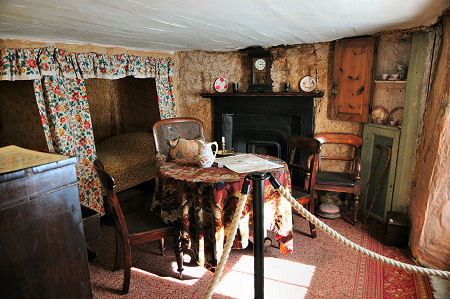 Inside The Parlour |

|
|
|
Visitor InformationView Location on MapSTB 3 Star Visitor Attraction Moirlanich Longhouse, Glen Lochay, Killin, FK21 8UA. Tel: 01567 820988. moirlanich@nts.org.uk Grid Ref: NN 562 342 www.nts.org.uk NTS: Longhouse Web Page Opening Hours Admission Accessibility What3Words Location: ///strictest.types.profile |
 Kitchen and Hanging Lum |
 Rear Bedroom |
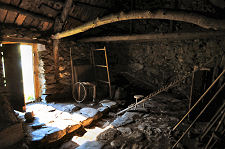 The Byre |
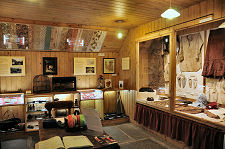 Inside the Exhibition |
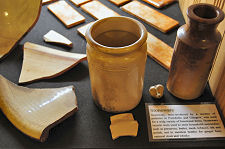 Display of Stoneware |
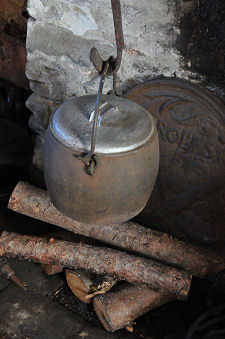 Cooking Pot on Kitchen Fire |

